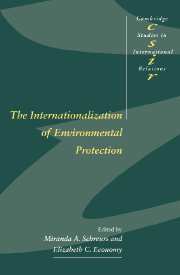Book contents
- Frontmatter
- Contents
- List of contributors
- Preface
- 1 Domestic and international linkages in environmental politics
- 2 Chinese policy-making and global climate change: two-front diplomacy and the international community
- 3 The domestic politics of global biodiversity protection in the United Kingdom and the United States
- 4 Domestic and international linkages in global environmental politics: a case-study of the Montreal Protocol
- 5 The internationalization of environmental protection in the USSR and its successor states
- 6 Domestic institutions and international environmental agendas in Japan and Germany
- 7 Zimbabwe and CITES: illustrating the reciprocal relationship between the state and the international regime
- 8 The European Union: bridging domestic and international environmental policy-making
- Index
- CAMBRIDGE STUDIES IN INTERNATIONAL RELATIONS
1 - Domestic and international linkages in environmental politics
Published online by Cambridge University Press: 08 March 2010
- Frontmatter
- Contents
- List of contributors
- Preface
- 1 Domestic and international linkages in environmental politics
- 2 Chinese policy-making and global climate change: two-front diplomacy and the international community
- 3 The domestic politics of global biodiversity protection in the United Kingdom and the United States
- 4 Domestic and international linkages in global environmental politics: a case-study of the Montreal Protocol
- 5 The internationalization of environmental protection in the USSR and its successor states
- 6 Domestic institutions and international environmental agendas in Japan and Germany
- 7 Zimbabwe and CITES: illustrating the reciprocal relationship between the state and the international regime
- 8 The European Union: bridging domestic and international environmental policy-making
- Index
- CAMBRIDGE STUDIES IN INTERNATIONAL RELATIONS
Summary
Introduction
In Lynton Caldwell's extensive historical account of the development of international agreements for environmental protection, he points to the 1972 United Nations Conference on the Human Environment (the Stockholm Conference) as the turning point in the development of a new paradigm in environmental thinking. As Caldwell writes,
The Stockholm Conference was a watershed in international relations. It legitimized environmental policy as a universal concern among nations, and so created a place for environmental issues on many national agendas where they had been previously unrecognized … [T]he growth of international environmental cooperation during the 1970s and thereafter is an aspect of a larger social transition. It is an expression of a changing view of mankind's relationship to the earth.
Pollution of the atmosphere, species loss, nuclear power safety, and ocean and sea pollution are some of the problems that are transforming the nature of international politics. As these issues become more and more pressing, the boundaries of states are increasingly blurred. The inefficient use of coal or the inability to treat a communicable disease in one state not only ravages that state's environment and populace but also has direct and frequently dramatic ramifications for other states. Individual states are ill-equipped to respond alone to the myriad challenges posed by transboundary environmental, social, and health problems. As the rapid growth in the number of international environmental agreements since the 1970s attests, the resolution of these types of problems requires extensive cooperation and coordination among states in the formulation and implementation of policies.
- Type
- Chapter
- Information
- The Internationalization of Environmental Protection , pp. 1 - 18Publisher: Cambridge University PressPrint publication year: 1997
- 6
- Cited by

